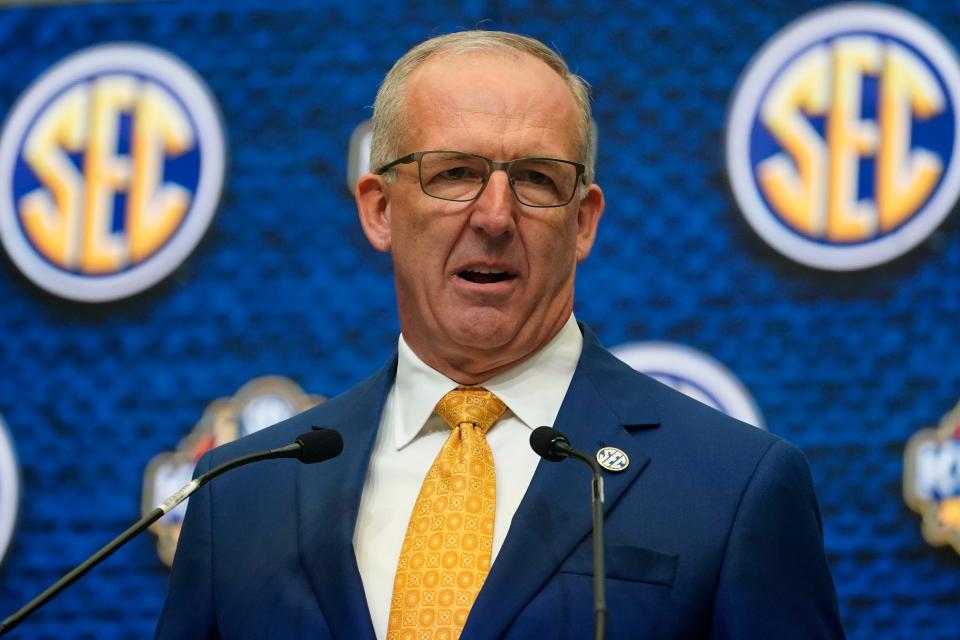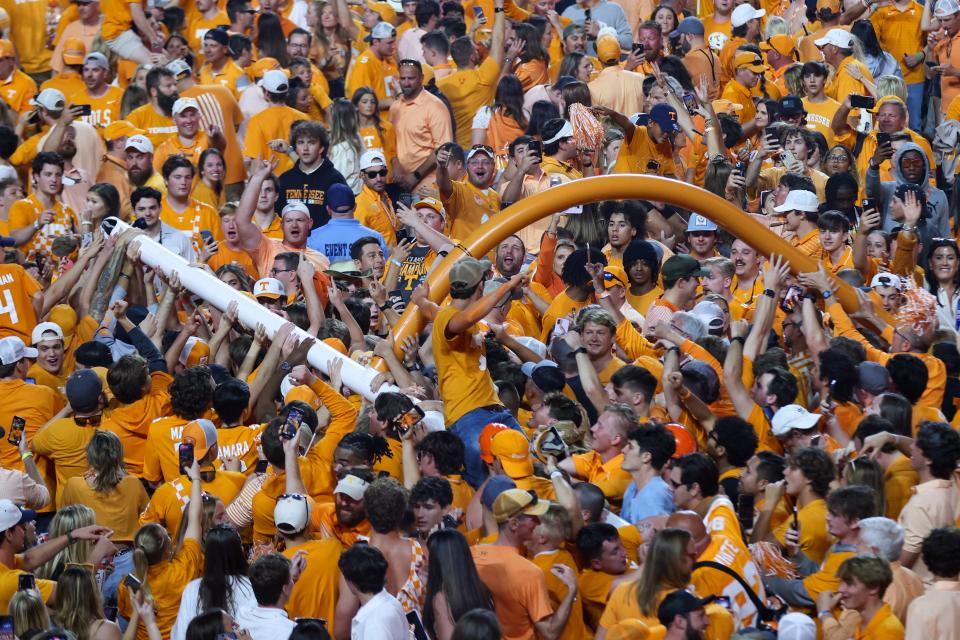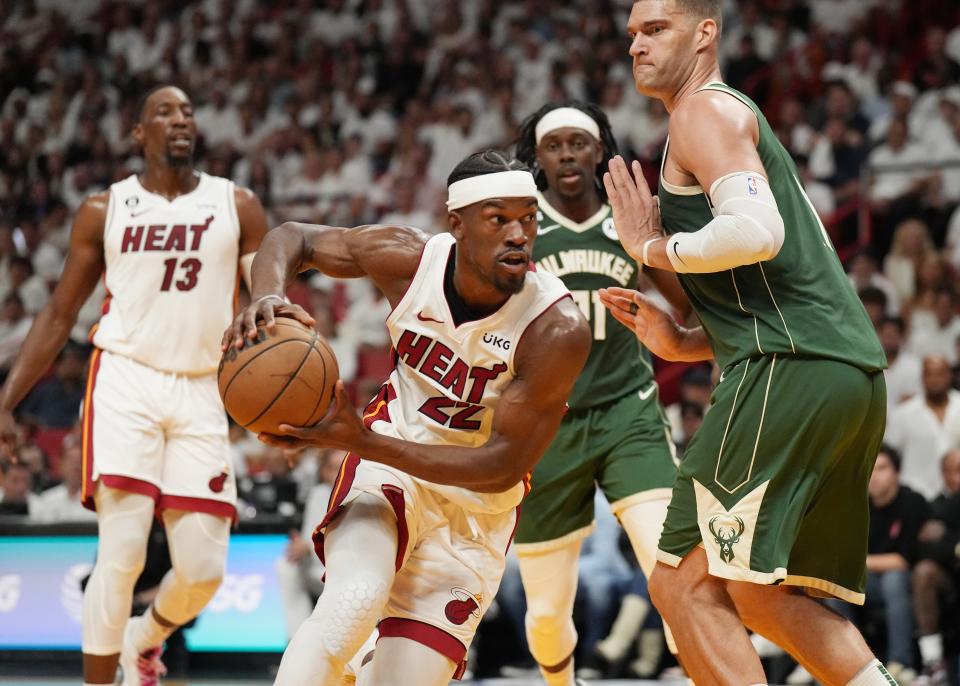Tramel: SEC field-storming proposal could take away home game from offending school
- Oops!Something went wrong.Please try again later.
- Oops!Something went wrong.Please try again later.
- Oops!Something went wrong.Please try again later.
- Oops!Something went wrong.Please try again later.
Tennessee upset Alabama 52-49 last October, tens of thousands Volunteers stormed the field, creating chaos for the Crimson Tide trying to get to its locker room, and Tennessee eventually was fined $100,000 by the Southeastern Conference.
University president Randy Boyd didn’t seem to care. With a victory cigar in hand that night, Boyd dismissed potential penalties. “It doesn’t matter,” he said. “We’ll do this every year.”
The SEC has tried to prevent fans from flooding the football field or the basketball court after big or upset victories. But the SEC has failed.
The SEC succeeds at many things, but not at keeping fans in the stands.
The conference, which OU will join in 14 months, is not giving up. Sports Illustrated reported that an SEC subcommittee has proposed removing a home game from the offending school.
The plan would work like this. If a fan base storms the field, the next time the two schools involved are scheduled to play at that site, the game would be reversed. In other words, if Tennessee fans storm the field after beating Alabama at Neyland Stadium in 2024, then the 2026 Bama-Tennessee game scheduled for Knoxville would instead be played in Tuscaloosa, giving Bama three straight home games in the storied rivalry.
More: Tramel: Does spring continue OU football monentum from Cheez-It Bowl?

Talk about a deterrent.
Field-storming is becoming a bigger rage than ever. Social media has created a copycat mentality.
Tennessee beating Alabama is a big deal. The Vols had lost 15 straight to the Crimson Tide. But a week after Tennessee-Alabama last season, Louisiana State fans stormed the field after beating Ole Miss. To the Tigers’ credit, that field-storming was rather peaceful and unprovocative.
But still. LSU was 16-6 against the Rebels this century. Ole Miss was ranked seventh, but LSU is supposed to beat Mississippi. Who’s next? Mississippi State?
Since 2004, the SEC has penalized schools with fines: $50,000 for a first offense, $100,000 for a second offense, $250,000 for any offense after that. But the SEC is so awash in cash, and a big victory is so impactful, money is no object.
“When people want to go, they want to go,” SEC Commissioner Greg Sankey told the SEC Network last November. “But we have to re-train people to stay in the stands.”
The threat of losing a home game would sober up anyone associated with the program, including fans. Can you imagine three straight Iron Bowls in Tuscaloosa?
If OU should upset Alabama or Georgia once the Sooners get into SEC play, I could see fans rushing Owen Field.
I remember two field-stormings in Norman – 1997 Syracuse and 2000 Nebraska. The first was an unexpected upset during dark Sooner days; the latter was a battle of unbeatens that returned OU to No. 1 in the nation for the first time in 13 years.
OSU’s most memorable field-storming was after winning 2011 Bedlam, securing the Cowboys’ first outright conference championship since Missouri Valley days.
More: OU football adds Texas receiver Brenen Thompson in transfer portal
Both events were dangerous. In Stillwater, just getting onto the field is precarious for revelers, since there’s a 10-foot drop after scaling the wall. In Norman, getting onto the field was easy, but the rush of humanity created an uncontrollable wave. In the Syracuse situation, I was moving at a relatively swift pace, and I was not moving my legs.
The SEC knows that eventually, tragedy or controversy will come to a field-storming. Tragedy in fan injury or death. Controversy in a physical altercation between fan(s) and a member of the visiting team, which we’ve already experienced on a small scale. A big scale is coming.
“The fact that field-rushing still happens means that the fine structure hasn't solved all of our problems,” Sankey said at an Associated Press Sports Editors regional meeting in Birmingham last week, according to the Tuscaloosa News. “I would expect some level of updates as we go into the year ahead, one of which is a higher expectation for security around the visiting team when those field incursions take place.”
But the SEC is looking for more inducements. Hence the subcommittee, made of athletic directors Mitch Barnhart (Kentucky), Greg Byrne (Alabama) and Josh Brooks (Georgia).
One problem: Kentucky, Alabama and Georgia are the schools most susceptible to being field-rush fodder – UK in basketball, Bama and Georgia on the gridiron. Fans have stormed the field after Alabama’s last seven SEC road losses.
Seems like a difficult mission to get the votes to support such a draconian measure as loss of a home game. What’s the motivation for the South Carolinas and Vanderbilts and Missouris to vote yes? Heck, Auburn and LSU, too?
OU athletic director Joe Castiglione said he had only read of the proposal, so he doesn’t know details or context.
But Castiglione said the loss of a home game could have unintended consequences that could “penalize many other people that have no control of a situation, including the team. Could cost them a championship, a playoff spot or whatever. Not to mention the loss of revenue to all parties which benefit from a home game.
“I totally get the need to send a stronger message but not sure that’s the right path.”
More: OU football report card: Peyton Bowen, defensive newcomers shine in Sooners' spring game
Another factor: Schools everywhere, including the likes of OU and Alabama, constantly work to keep fans engaged and interested in buying tickets and coming to the games.
Students are at the top of that list. Any measures that restrict students from perceived merriment would have an adverse effect on those marketing efforts. And that matters.
How do you keep people in the stands? Extra security seems fruitless. Mounted police? That worked at Yankee Stadium in the crazy 1970s, but is that the image universities want to project?
What is the delineation of field-storming? Do 1,000 fans make you guilty? Five thousand? Ten thousand?
What if the field-storming is orderly? Texas Christian was fined $50,000 by the Big 12 last season when Horned Frog fans rushed the field after beating OU, but a couple of weeks later, TCU fans did the same after beating OSU, with no consequences from the league. It seemed as if the Cowboys had a clearer path to exit the field.
Is that what we need? A field-storming gameplan. Hit the grass but keep open the path designed to allow the visiting team to get off the field unencumbered. Maybe that’s where the mounties come in; not to keep fans off the field, but to direct them to certain areas.
I don’t know. It’s a mob mentality, and it’s difficult to motivate mobs. People lose their sense of right and wrong in a mob. They don’t think coherently.
But maybe three straight Iron Bowls in Tuscaloosa can do the trick.
Tramel: Kyler Murray's patience pays off with statue befitting a Heisman Trophy winner

Mailbag: Brent Venables
Some fans remain solidly in Brent Venables’ corner, as the OU coach deals with the fallout of a 6-7 season.
Tom: “I heard Dean Blevins say on the (Sports) Animal a few nights ago, Brent Venables has not yet proven he can win as a head coach. That is true, although I believe he will. Something not mentioned in that discussion, a number of established college coaches are struggling, Mike Gundy and Jimbo Fisher especially. Crazy times, and would not be surprised if this will be Gundy's last season. May I gently remind, Venables was semi-run off from OU when he left for Clemson, in the excitement of his return that was forgotten. I mention this to say he is just human and can only do so much. He came back at a terrible time and the turnaround may take time, something his boss may not feel he can give him long term.”
Tramel: Dean is not the only person who has said it. It’s fairly accepted. Venables indeed is not yet a proven winner.
The Gundy and Fisher comparisons are vastly different, because while they had disappointing 2022 seasons, they also have won big in the past. Venables has not. That’s a big difference.
I don’t think Venables will lose his job with another losing season, but you never know. College football is high-stakes business. Universities no longer wait for success.
More: Tramel's ScissorTales: Why OSU football's Thursday night opener tradition is on hiatus
Thunder report card: Dario Saric
The Thunder traded Darius Bazley to Phoenix in February for Dario Saric and a second-round draft pick, in what essentially was a cost-cutting deal for the Suns and an additional draft pick for OKC. But along the way, the Thunder ended up with a player it counted on more.
We continue our series on Thunder report cards, today with Saric, the seven-year pro from Croatia.
Adjustment: A. The Thunder didn’t depend on Saric wholesale. He arrived with 28 games left in the season; he played in 20 games, during which the Thunder was 9-11. OKC was 5-3 in the eight games he missed. But Saric averaged 13.7 minutes a game, slightly less than Bazley’s 15.4 and slightly less than the 14.4 Saric was averaging with the Suns this season. But Saric was a valuable hand. His on/off numbers were third-best on the team – per 100 possessions, the Thunder was 8.5 points better with Saric on the court than when he sat. That was third-best on the team.
Ballhandling: D. Saric did not protect the ball. He averaged 2.5 turnovers per 36 minutes, which is in line with his career (2.3) and his 37 Suns games this season (2.4). Saric’s turnover rate of 14.4 (percentage of his possessions that ended with a miscue) was second-worst on the team, behind only Josh Giddey, a point guard. And Saric’s assists per 36 minutes (2.2) was among the lowest on the squad.
Scoring: A. Saric averaged 19.4 points per 36 minutes. How good is that? Second on the Thunder, behind only Shai Gilgeous-Alexander. And Saric was not a volume scorer; he was second on the team in true-shooting percentage, at .650 (percentages that factor in foul shots and 3-point value). Saric’s previous best true-shooting percentage was .592 three seasons ago with Phoenix, so the Thunder brought out the best in Saric.
Defense: C. Saric’s defense wasn’t terrible. But it wasn’t what the Thunder needed. For the entire season, OKC and Phoenix, Saric allowed 56.7 percent shooting on 2-pointers when he was the primary defender. That’s not good. In one of the seasons’ biggest games, Saric was inserted midway through the fourth quarter and the Thunder trailing Charlotte 106-103. In Saric’s 3:05 of playing time, the Hornets scored 17 points on eight possessions, and the score ballooned to 123-110.
Shooting: A. Saric was not a volume 3-point shooter, so he never stood out. With the Thunder, Saric only once made more than two 3-pointers in a game and only thrice took more than four 3-pointers. But he was more than solid on the deep balls, making .391 percent. And that’s without much work in the corners, where he made four of seven with OKC. And Saric wasn’t one-dimensional – his overall field-goal percentage of .515 was third-best on the team.
Tramel: OKC Thunder guard Shai Gilgeous-Alexander finishes second for NBA's Most Improved Player
The List: Single-game NBA playoff scoring
Back in February, Jimmy Butler was left off the NBA’s Eastern Conference All-Star team. Some pundits howled at the lunacy. They were right.
Butler on Monday night turned in one of the greatest individual playoff performances in NBA history. Butler scored 56 points and rallied the Miami Heat from an 11-point deficit in the final eight minutes to a 119-114 victory over Milwaukee, to put the Bucks in a 3-1 series hole.
Here are the 13 times in NBA history a player has scored at least 55 points in a playoff game:
1. Michael Jordan, 63, 1986: In the Bulls' 135-131, double-overtime loss in Boston, Jordan made 22 of 41 shots.
2. Elgin Baylor, 61, 1962: In the Lakers’ 126-121 win at Boston, Baylor made 22 of 46 shots.
3. Donovan Mitchell, 57, 2020: In the Jazz’s 135-125 overtime loss to Denver in the Orlando bubble, Mitchell made 19 of 33 shots.
4. Charles Barkley, 56, 1994: In the Suns’ 140-133 win at Golden State, Barkley made 23 of 31 shots.
4. Jimmy Butler, 56, 2023: In the Heat’s 119-114 win vs. Milwaukee, Butler made 19 of 28 shots.
4. Wilt Chamberlain, 56, 1962: In the Philadelphia Warriors’ 121-104 win vs. Syracuse, Chamberlain made 22 of 48 shots.
4. Michael Jordan, 56, 1992: In the Bulls’ 119-114 win at Miami, Jordan made 20 of 30 shots.
8. Rick Barry, 55, 1967: In the Warriors’ 130-124 win vs. the 76ers, Barry made 22 of 48 shots.
8. Allen Iverson, 55, 2003: In the 76ers’ 98-90 win over New Orleans, Iverson made 21 of 32 shots.
8. Michael Jordan, 55, 1988: In the Bulls’ 106-101 over Cleveland, Jordan made 24 of 45 shots.
8. Michael Jordan, 55, 1993: In the Bulls’ 111-105 over Phoenix, Jordan made 21 of 37 shots.
8. Michael Jordan, 55, 1997: In the Bulls’ 109-104 win over Washington, Jordan made 22 of 35 shots.
8. Damian Lillard, 55, 2021: In the Blazers’ 147-140, double-overtime loss to Denver, Lillard made 17 of 24 shots.
More: OU football report card: Peyton Bowen, defensive newcomers shine in Sooners' spring game

College football timing rules change
After 55 years, college football has scrapped a poorly-designed timing rule. The clock no longer will stop after a first down, until the final two minutes of each half.
The NCAA approved three timing changes last week. Consecutive timeouts by the same team no longer will be allowed, and there no longer will be untimed downs after penalties ending the first and third quarters. But the big change is the first-down stoppage.
Keeping the clock running after first downs is expected to eliminate seven plays a game, which could shorten games by a few minutes. Games in recent years have grown to an average of three hours, 22 minutes, in Division I.
The primary problem with longer games is fitting games into television windows. Too many TV games are starting on streaming platforms or other cable channels, waiting for the preceding game to finish.
The first-down clock rule was established in 1968, but the National Football League did not adopt the policy, and the NFL has run much more streamlined games.
Unfortunately, college football will suspend the new rule for the final two minutes of each half.
Over the years, officiating crews have become much more adept at getting the clock moving after first downs. Sometimes, the stoppage is only a few seconds, as referees policed slow play on their own by keeping the game moving.
Interestingly, the new rule was not adopted for Division III. D-III games rarely are televised.
That’s not the case in Division I-A, where games are not fitting into television windows.
Berry Tramel: Berry can be reached at 405-760-8080 or at btramel@oklahoman.com. He can be heard Monday through Friday from 4:40-5:20 p.m. on The Sports Animal radio network, including FM-98.1. Support his work and that of other Oklahoman journalists by purchasing a digital subscription today.
This article originally appeared on Oklahoman: OU football: SEC field-storming proposal could take away home game

